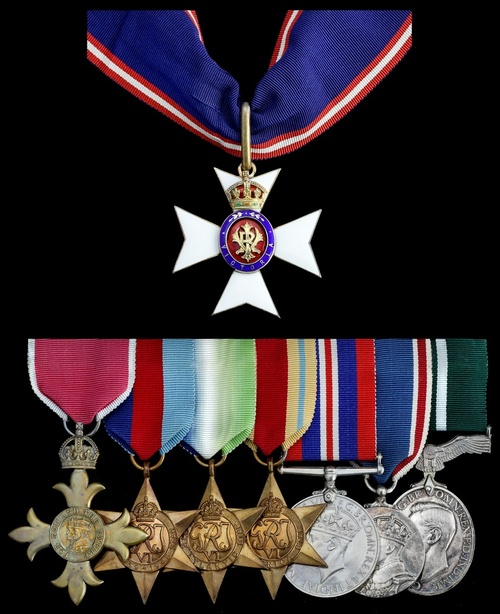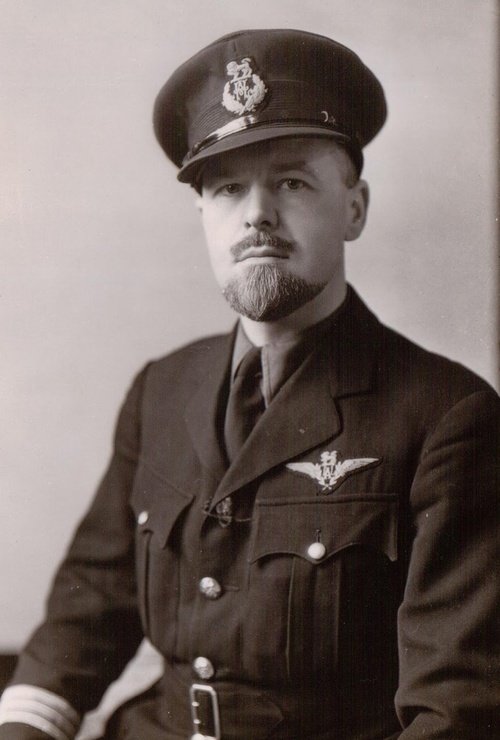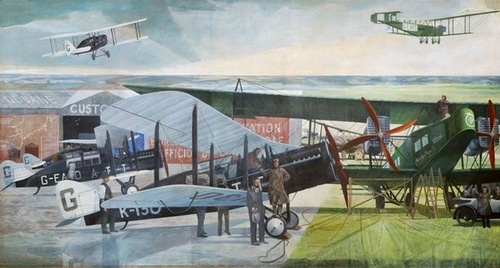Auction: 18001 - Orders, Decorations and Medals
Lot: 19
'When Imperial Airways launched their new, glamourous cross-Channel 'Silver Wing' service at the beginning of the 1930s, 'OP' was among the first batch of pilots who had to put away their old, stained leather flying suits and adopt the new image of a pilot captain resplendent in a dark blue uniform and peaked cap, reminiscent of a Navy captain.
'OP' appeared to relish his celebrity status. By this time he had adopted a 'piratical' beard - which he kept for the rest of his life - and enjoyed the frisson of recognition which greeted his appearance at the airport just fifteen minutes before take-off was due. He would give a cursory glance to the weather charts and then stroll onto the tarmac, often pausing at the top of his entry ladder for a photo opportunity.
The flying public adored his charisma and often asked for him by name when booking flights. He was also well-known for his skill and calm in tricky situations … '
An article by Cheryl Bailey on The Croydon Airport Calling website, refers.
An important 'Royal Visit' pilot's C.V.O., Second World War civil O.B.E. group of nine awarded to Captain O. P. Jones, British Overseas Airways Corporation (B.O.A.C.), late Royal Air Force Volunteer Reserve
A pioneer of civilian flight and one of the first pilots for Imperial Airways, he flew the famous 'Silver Wing Service' out of Croydon to the Continent in the 1920s and 30s, and became the first pilot to transport a member of the royal family on the occasion of H.R.H. the Prince of Wales's visit to Paris in 1926
Although a Wing Commander on the Reserve of Air Force Officers - he was awarded the Air Efficiency Award in 1943 - he flew as civilian pilot and Flight Captain on the Atlantic run in the Second World War, in addition to serving as Flight Captain, Landplanes 1942-45
He remained employed as a Senior Captain in B.O.A.C. until 1955 and was awarded his C.V.O. for H.R.H. Princess Elizabeth's visit to Canada in 1951
A colourful character who was the subject of many anecdotes, 'OP' became known as 'The Grand Old Man of British Civil Aviation': no wonder he was chosen as one of those to be depicted on Heathrow's mural dedicated to the early pioneers of British aviation
The Royal Victorian Order, Commander's (C.V.O.) neck badge, silver-gilt and enamel, the reverse officially numbered '1145', in its Collingwood & Co. case of issue; The Most Excellent Order of the British Empire (O.B.E.), Civil Division, Officer's 2nd type breast badge, silver-gilt and enamel; 1939-45 Star; Atlantic Star; Africa Star; War Medal 1939-45; Coronation 1937; Air Efficiency Award, G.VI.R., 1st issue (Fg. Off. O. P. Jones, R.A.F.V.R.), mounted as worn where applicable, together with the recipient's Guild of Air Pilots and Air Navigators Deputy Master's neck badge, gilt and enamel, the reverse engraved, '1934, O. P. Jones', in its Thomas Fattorini case of issue, good very fine or better (9)
C.V.O. London Gazette 1 January 1952.
O.B.E. London Gazette 15 June 1945.
Oscar Philip 'OP' Jones was born on 15 October 1898, the son of Oscar Jones of Beckenham. Educated locally, he enlisted in the Royal Engineers in 1916 but quickly transferred to the Royal Flying Corps. As verified by his subsequent R.A.F. service record, he remained employed in the U.K. and did not qualify for any campaign awards.
A pioneer of civil aviation
He had nonetheless gained his 'Wings' and in 1920 he commenced his long association with civil aviation when he joined Berkshire Aviation Tours. Two years later he joined Instone Airlines, which company was taken over by Imperial Airways in 1924. It was in this capacity that 'OP' gained his laurels on the continental run, operating out of Croydon on the 'Silver Wing Service'; he gained his Master's Pilot's Certificate in 1935.
These early - exciting - days of civil aviation attracted considerable press coverage, a case in point being the occasion 'OP' became the first pilot to transport a member of the royal family when, in 1926, he flew H.R.H. The Prince of Wales to Paris. A glimpse of that early excitement - and glamour - is to be found in the pages of Harald Penrose's Wings Across the World - An Illustrated History of British Airways:
'Though the press made sensational news of air accidents it was equally ready with stories of derring-do and even about airline pilots. One of the first to feature was Captain Oscar Philip Jones, known as 'O.P.' by his contemporaries but more cautiously by juniors whom he addressed as 'Mister'. He was headlined in May 1934 as the air pilot who had flown one million miles and carried 65,000 passengers without accident, but it was his air of command and raking jutting beard which intrigued newspapermen.'
'OP' may have avoided accidents but his flights were not without incident:
'Snags with the Jaguar engine were persisting. On 8 December 1926 an Argosy piloted by O.P. Jones, en route for Croydon, broke a tappet rod and then oil pressure dropped on another engine, but he landed safely at nearby Pluckley and sent the twelve passengers on by train to London. Replacing the tappet rod next day he flew to Croydon, arriving at the same time as the first of the triple-engined D.H. Hercules' (ibid).
The weather did not help either:
'On 9 May 1932 ... the sister airliner (H.P. 42) Horatius, flown by O.P. Jones, with thirteen passengers aboard, was climbing through cloud to reach clear skies above Tonbridge when lightning fused the trailing aerial, burnt out the wireless installation, and dislodged a window which damaged the adjacent propeller, resulting in considerable vibration, so Jones turned back and landed again at Croydon - but five of his passengers refused to continue after that experience, though the other eight left with him soon afterwards in the Helena' (ibid).
'In England a glorious Easter 1939 produced a record number of air travellers, 40 machines leaving for Paris and 30 for Le Touquet during Thursday and Friday, and extra aircraft were required on the Scandinavian and Austrian routes. Heracles, returning at midnight, encountered a phenomenal bump over Croydon which put Captain O. P. Jones through the roof and injured the crew, so that all appeared in bandages the next day; luckily the steward and stewardess had insisted on the passengers securing their belts' (ibid).
Second World War
'OP's' wartime career commenced with a stint of duty as O.C. of No. 2 Air Transport Auxiliary (A.T.A.) Pool but in 1941, following the establishment of B.O.A.C., he commenced service as a Flight Captain on the Atlantic run for R.A.F. Ferry Command.
A glimpse of him at work is to be found in Charles Woodley's B.O.A.C.: A History:
'On 24 September 1941 the running of the Return Ferry Service was handed over in its entirety to B.O.A.C., operating under the A.O.C. R.A.F. Ferry Command. Ten Liberators were provided by the R.A.F., but B.O.A.C. took full responsibility for their maintenance, operations and crewing. The first crossing under B.O.A.C. control took place on that date, under the command of Captain O. P. Jones, and services were operated from then on six days of each week.'
A further glimpse of 'OP' at work is to be found in Harald Penrose's above quoted history:
'The route to Russia was also changed in 1943, for the hazards had become too great, and it was agreed that B.O.A.C. should fly direct to Moscow by a Mediterranean route which Captain O. P. Jones pioneered with Mr. Maisky, the Russian ambassador, aboard. From Cairo they flew to Habbaniya near Baghdad, then skirted the Caspian Sea to Kuibyshev, but on his return flight Captain Jones made for Teheran, and this became the adopted route flown by Liberators.'
He was awarded the O.B.E., which distinction he received from H.M. The King at Buckingham Palace on 15 November 1945; he had earlier - in November 1943 - been awarded the Air Efficiency Award.
Post-war
Immediately after the war, B.O.A.C. pilots of the Atlantic Ferry were allocated to the Constellation trans-Atlantic programme, 'OP' setting quickly setting the pace. Charles Woodley's above quoted history takes up the story:
'On 16 June 1946 L-049 Constellation G-AHEM 'Balmoral', under the command of Captain W. S. May, operated the first of ten B.O.A.C. Constellation trans-Atlantic proving flights, and set a record of 11hrs. 24mins. for the New York-London journey. These flights paved the way for the inauguration of twice-weekly scheduled services between London and La Guardia Airport, New York on 1 July 1946, with G-AHEJ 'Bristol II' operating the first service under the command of Captain O. P. Jones.'
Moreover:
'On 1 March 1951 the De Luxe 'Monarch' service from London to New York was inaugurated, initially on a three-times-weekly frequency, but upgraded to daily from 1 May. The first westbound service was commanded by Captain J. T. Percy, and the first eastbound schedule by Captain O. P. Jones, flying G-ALSB 'Champion'. Captain Jones was almost a legendary figure on the transatlantic services of this period, commanding most of the inaugural services, as befitting his great experience' (ibid).
Later in the same year, Jones undertook an equally important duty. Harald Penrose takes up the story:
'The highlight of B.O.A.C's activities in October 1951 was the midnight flood-lit departure to Montreal of Princess Elizabeth and the Duke of Edinburgh aboard the Stratocruise flagship Canopus, commanded by that distinctively bearded personality Captain O. P. Jones.'
'OP' was awarded the C.V.O., which distinction he received from H.R.H. The Duke of Gloucester at Buckingham Palace on 5 March 1952.
Penrose continues:
'But now came historic change. Churchill at 80 resigned the premiership. Elections in May 1955 resulted in victory for the Conservatives and Sir Anthony Eden became Prime Minister. That month another famous personality resigned: Captain O. P. Jones of the much-publicized jutting beard. At 56 he had completed 21,600 hours, crossing the English Channel 6,000 times and the Atlantic 300, carrying 140,000 passengers. Such long and devoted service earned an illuminated certificate.'
Having stepped down from the flight deck, 'OP' was appointed a Special Liaison Officer for B.O.A.C's Worldwide Goodwill and Lecture Tours, in which capacity he remained actively employed until 1965.
A founding member of the Guild of Air Pilots - he was deputy Master of the Guild in 1934 - he served as Warden 1954-58. He was also a member of the Speedbird Club and served as President of B.O.A.C's '25' Club in 1952. The winner of the Cumberbach Trophy (1931) and the Britannia Trophy (1951), he was awarded his Guild Master Pilot's Certificate in 1955.
Described as 'The Grand Old Man of British Civil Aviation', 'OP' retired to Pulborough in West Sussex and died in June 1980.
One or two anecdotes
'OP' is the subject of numerous anecdotes on assorted websites, one of which describes an early post-war cross-Atlantic flight:
'It was O. P. Jones who - according to my father - had been commanding a flight across the Atlantic shortly after the War, in an unidentified aircraft type, and was back at the navigator's table, pouring over the charts and smoking the pipe for which he was universally known and recognised. Jones was head down and deep in discussions with the Navigating Officer, when the F.O. turned around to ask a question, and the F.O.'s knee hit the gang bar covering all eight magneto switches, turning them all off simultaneously, and thus causing all four engines to shut down at once, some 20,000 feet plus over the ocean at night. An impenetrable, shocked silence settled over the entire flight deck, with everyone frozen involuntarily in their places and appalled looks on everyone's face. No-one was able even to say a word. O. P. Jones did not turn a hair, and without so much as looking up, he simply took the pipe out of his mouth and said: "Quiet, isn't it?," and replaced his pipe in between his teeth.
Of course, the engines were quickly re-started, and being out of radar coverage with few if any other aircraft in the sky then, nothing else happened and nothing more was reportedly said about the incident. But O. P. Jones was hard to beat for sheer sang froid … '
Another cross-Atlantic run:
'One night, the veteran B.O.A.C. Captain, O. P. Jones, was approaching the weather ship and picked up his microphone to make contact. However, a sailor was having a conversation with the stewardess on the American aircraft ahead, and all he could hear through the headphones was ... 'I'm twenty two, five feet four inches, thirty-five, twenty-two, thirty-five, blonde hair, blue eyes. My flat is in 16 Brooklyn Park, telephone 5652 … ' 'Jesus honey, we're practically neighbours. Can you cook!' … 'Everybody says my apple pie … ' 'Honey, I'll be right over. That is in three weeks and two days and five hours time.'
Eventually there was a break in the conversation and Captain Jones spoke: 'This is Speedbird Easy Love ... I'm fifty-one years old, five feet nine inches tall, forty-two, thirty-two, thirty-five, blue eyes, a torpedo beard ... I'm interested in breeding bull terriers and I live in Sussex, England. My cooking is well known. Do you want my telephone number?' There was an astonished silence before the one word ... 'No-o-o.' 'Then can I,' said Captain Jones, 'have the wind at 19,000 feet?'
Lasting memorial
In 1969, William Kemspter, A.R.C.A., was commissioned by the British Airports Authority to paint a special mural for the opening Heathrow's Terminal 1. The finished product - entitled 'The History of Aviation' - measured a staggering 8.4m in length and was unveiled by H.M. The Queen and the Duke of Edinburgh.
The three-section mural pays homage to the early days of civil aviation, to Croydon Airport and to the pioneering pilots who made it possible, among them 'OP' who stands centre stage in one of the sections.
The mural is currently on loan to the Historic Croydon Airport Trust by the Maas Gallery, in London until the end of 2018 and can be viewed in the former Booking Hall in Airport House on the Purley Way.
Subject to 20% VAT on Buyer’s Premium. For more information please view Terms and Conditions for Buyers.
Sold for
£2,200









